Project Log: Sunday,
February 14, 2010
Home Page >
The Project >
Project Logs > 2/14/10 |
Generally lacking motivation, and
specifically lacking the materials required for the aft hull
repairs (which I planned to have on hand within the next
week or two), I turned to a mindless, unrelated (at least at
this early stage), yet ultimately necessary task:
dealing with the ports. Metal cleaning and similar
busywork were not high on my list of favorite activities at
any time, so rather than ignore the pile of ports till one
day when it was time to reinstall them, at which point I'd
begrudge the process all the more, I thought it might be
better to start the process very early, allowing me to
spread the work out as time and endurance allowed, and to
give it the attention deserved.
#16 came complete
with the original bronze deadlight frames (4 pair) and
bronze opening ports (6); the previous owner had removed
them from the boat sometime after the fire and before my
purchase, and these items had been in storage in my shop
ever since. They were valuable items, though--bronze
ports being expensive and difficult to come by in this day
in age--and were be one of the few items I'd planned on
reusing from the beginning. I hoped to clean them to
bright metal and clear powdercoat--or at least clear LPU, if
powdercoating turned out to be an unrealistic option.
Fortunately, the ports and deadlight frames appeared
to be in good condition, though badly in need of
refurbishment. The plastic lenses from the deadlights
were charred and heat-damaged, and the condition of the
glass lenses in the opening ports ran the gamut from
shattered and missing to simply badly smoke-stained.
But other than the staining from age, smoke, and weathering,
the bronze components were in excellent condition.
These bronze ports, along with some of the other bronze
hardware that came with the boat, would be highlights of the
finished boat's appearance someday.
|
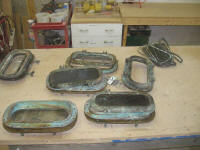
 |
I brought the bronze castings down to my bench, and
approached the disassembly of one of the opening ports, one
which featured shattered glass. I thought taking one apart
would help me determine how much of a chore the remaining
task might be. In any event, I didn't plan to attack all the
ports, nor begin the cleanup process: this was
reconnaissance only. Besides, I'd recently trashed the
wire wheel I had while doing another job, and needed to get
the proper equipment before I began to clean up the metal.
The opening portion of each port had already been
disassembled from the main body, apparently during their
original removal by the previous owner, so to prepare the
castings for further cleanup and refurbishment it was a
matter of removing the lens.
In the slot that
contained the port gasket, 10 small bronze screws secured
the trim flange that, along with glazing compound, secured
the glass lens in place. The first screw head I tried
to remove stripped almost immediately, despite what I
thought was a modicum of care in my technique, so I
reevaluated and tried other screws. Fortunately, I
found I could successfully remove 7 of the 10 screws; the
other three stripped out, forcing me to drill out their
heads. This wasn't a big problem, as I could easily
redrill and tap new holes for additional screws later (much
later) during the reassembly or cleanup process.
I
scraped away the minimal remaining sealant from the port's
mating surfaces--fortunately not the hated silicone, but an
oily, soft compound more like Dolfinite--and set the pieces
aside, being sure to keep them together with each other.
Since I completed this task only while killing time
waiting for a meeting at the shop, I only disassembled the
one port for now, but it gave me a realistic idea of what
lay ahead. I ordered wire brushes and wheels, and
would continue the process as time and inspiration allowed. |
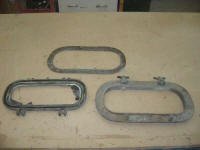
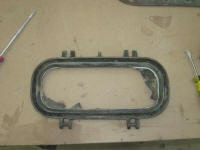
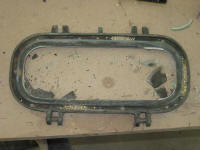
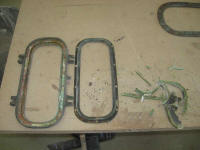 |
Total Time Today: 1 hour |
Previous | Next |
|
|